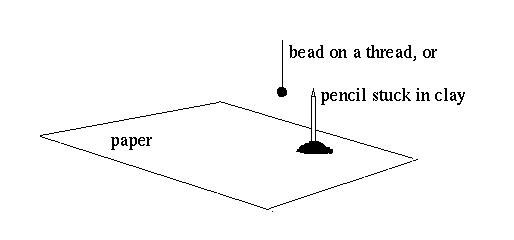
So what we do is:
In more detail, (1) To pick a time that is convenient,
first pick a window where your observatory will sit. The observatory cannot
be moved over the course of the semester! The observatory can be outside.
If at a window, the window cannot face north (no sun). An east window can
be used only in the morning, a west window can be used only after noon -
follow me? The convenient time must also fit in with your schedule - near
a meal is probably best. (2) Make your observatory, something like this:

Ironclad rules: (A) observations must be made within 5 minutes of your chosen time. (B) the farther away your shadow-casting object (bead or pencil) is from the paper the better. 6 inches is absolute minimum - at that scale you will be writing very tiny. 12 to 18 inches is better. (C) The observatory must not be moved (or must be replaced in exactly the same place each time). "Exactly" means less than 0.2 inches (for a 6-inch object-paper separation) movement between observations. If somebody bumps the observatory (drat!), fix it like this: during the next observation time, align it so that the sun shadow lines up on the last marked position. The sun doesn't drift far in a day or two.
Polish: When you get ready to hand in this project, put the following finishing touches on it. Mark North-South-East-West directions on it as best you can (should be easy if you are near or inside a building, since they are always aligned N.S.E.W.). For at least one of the observations, trace the path of the shadow over plus and minus one hour from the time of observation. Measure with a ruler the distance from the paper to the object and include this number in your report. Question to answer: your observations stretch about 1/4 of a year; predict using your astronomical acumen what your sun-shadow will do the rest of the year. Question to answer: explain how you could tell a farmer when to plant, even if all the world's calendars spontaneously combusted.
Alternative Observing Strategies: (1) Dorm room ceiling projection: put a small bit of mirror on the window sill or floor and chart the progress of the reflected spot of light on the ceiling or wall (tape or tack paper there). (2) Exploit the architecture: use the shadow cast by a building cornice or other projection on the grass. Mark the spots with labeled toothpicks or popsickle sticks. Such a large baseline will yield excellent results. Mark the final result on butcher paper. Or take a photo.